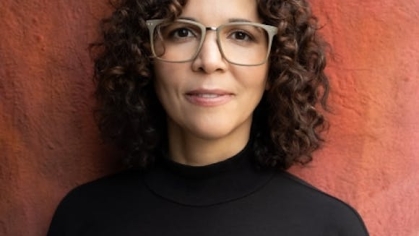A ribbon cutting marks the official reopening of 15 Washington. From left to right: Rutgers VP for Facilities and Capital Planning Anthony Calcado, Former RU-N Interim Chancellor Phillip Yeagle, Rutgers President Robert L. Barchi, State Senator Ronald Rice, Rev. Dr. M William Howard, Former RU-N Chancellor Steven Diner, Mrs. Henrietta Parker, RU-N Advisory Board Chair Oliver Quinn, RU-N Chancellor Nancy Cantor, and RU-N Advisory Board and Rutgers Board of Governors Member Richard Roper.
One of Newark’s most distinctive buildings, 15 Washington Street, was the site of a jubilant re-opening on Tuesday, November 17, closing a 15-year chapter in its history marked by uncertainty and signaling a new era of hope and inclusiveness. Its cavernous Great Hall, empty just days before, was filled by hundreds as the venue for a quadruple celebration at Rutgers University–Newark (RU-N): the building’s own grand reopening, Rutgers’ 250th anniversary, Newark’s 350th anniversary, and a celebration of the contribution of the Rev. Dr. M. William Howard to Rutgers and to Newark upon his retirement as pastor of Bethany Baptist Church.
“It is so fitting that this be a celebration of university – Rutgers University–Newark as part of Rutgers 250th, and community – Rutgers University-Newark as part of Newark’s 350th,” RU–N Chancellor Nancy Cantor said. “It’s fitting on so many levels, not the least of which, is that this incredible neoclassical building is not just an icon of Rutgers University-Newark, but an icon of the city of Newark…the same architects designed [Newark] City Hall. Isn’t that a fitting way of thinking about the intertwining of Rutgers University–Newark and the City of Newark?”
Cantor expressed her greatest aspiration for 15 Washington as seeing it become “a key piece of Newark’s civil infrastructure that will help us build a more just social infrastructure,” reminding the university and community members gathered that historically “buildings like this, the companies that occupied them, and indeed opportunity overall were not open to all on equal terms—legacies that we still struggle to overcome today.” She sees the key to winning that struggle in the diverse and talented students of Rutgers University – Newark, especially the more than 330 graduate and undergraduate students who moved into the newly renovated skyscraper in August 2015. She expressed eagerness to join them when she moves into the Rutgers University–Newark Chancellor’s residence in the building in the coming weeks.
The building’s new status as a residential space was praised by Newark Mayor Ras Baraka who shared Cantor’s enthusiasm and hailed the arrangement as a strengthening of RU-N’s and Newark’s mutual embrace.
“This building will be an example, an example of Newark kids going to Newark universities, being a part of a new Newark where the city and the university become entangled in the same future...” Baraka said.
Emceed by Rutgers University–Newark Advisory Board Chair Oliver Quinn, Esq., the evening featured speakers highlighting 15 Washington as a symbol of future prosperity, mirroring its opening in 1930 when it emerged as a place of opportunity following the stock market crash of 1929. In 2015, it stands alongside the businesses, artistic hubs, and recreational spaces that spur Newark’s current revitalization.
State Senator Ronald Rice presented Chancellor Cantor with a resolution from the New Jersey State Legislature commending Rutgers University – Newark for the building’s renovation and the investment in the city and people of Newark that it represents.
The celebration held a personal significance for many in the room who have watched 15 Washington’s transformation throughout the years, one of whom was retired Due Process producer, Henrietta Parker. Parker, one of the evening’s speakers, treated the crowd to a history lesson wrapped into a tribute to her late father, Frederick Parker.
Parker reflected on her childhood days admiring the Newark skyline with her sister as they searched for their “daddy’s building” at 15 Washington (then the American Insurance Company). Parker’s father was hired in 1946 as the American Insurance Company’s first African-American employee. More than 30 years later, the building was acquired by the Fireman’s Fund Insurance Company, which donated the building to RU–N in 1979.
“Daddy was happy to hear that Rutgers had decided to keep this building, and use it as its law school,” Parker recalled. “He was glad to see that this building had survived the wrecking ball, an all too familiar piece of equipment used in Newark.”
The building thrived under RU-N’s ownership as the S.I. Newhouse Center for Law and Justice from 1979 to 2000, but was mothballed when the Rutgers Center for Law and Justice was built as the new location for all of 15 Washington's offices. For 15 years it sat, reemerging in 2015 to become a symbol of resilience and opportunity.
“I have to say that the dedication of this facility only accentuates the pressure for those who continue to labor in the vineyard here to never give up on the creation and preservation of one city,” said Rev. Dr. M. William Howard Jr., challenging the event's attendees to remain dedicated to combatting economic and social disparities. On a night recognizing Rutgers' anniversary as “Revolutionary for 250 Years,” Richard Roper, representing the RU-N Advisory Board and the Rutgers Board of Governors, honored Howard for his service on the Rutgers Board of Governors (2004-2014), including as its first African-American Chair.
The RU-N Advisory Board presented him with a Resolution acknowledging his “exemplary, ongoing, and selfless support of Rutgers University for ten years” and offering gratitude for “inspiring, through his mentorship and guidance, diverse new generations of students to become the leadership of the City of Newark, inspiring Newark residents to achieve their full potential through education, and inspiring the faculty, staff, and administration of Rutgers University–Newark to strive to embody the nurturing institution needed to realize those aspirations as an anchor institution in this great city.”
Rutgers President Robert L. Barchi also acknowledged Howard for his role in uplifting the city and pointed to 15 Washington as a symbol of RU–N’s role as an anchor institution in Newark. “We’re standing here with this building reopening because we’re looking forward. We’re celebrating the future and where we’re going,” Barchi said. “[RU-N] has a ton of exciting new initiatives like Express Newark and the Newark City of Learning Collaborative; it has a strategic plan that is really committed to investing in excellence, leveraging diversity, and building that civic dialogue.”
“I could not be more excited as president to look at Rutgers, look at Rutgers University–Newark, and see where it’s going, its resurgence, building on a legacy of what it’s done before, and building with partners like Bill Howard…it’s going to be a great time.”
Photo: Anthony Alvarez


